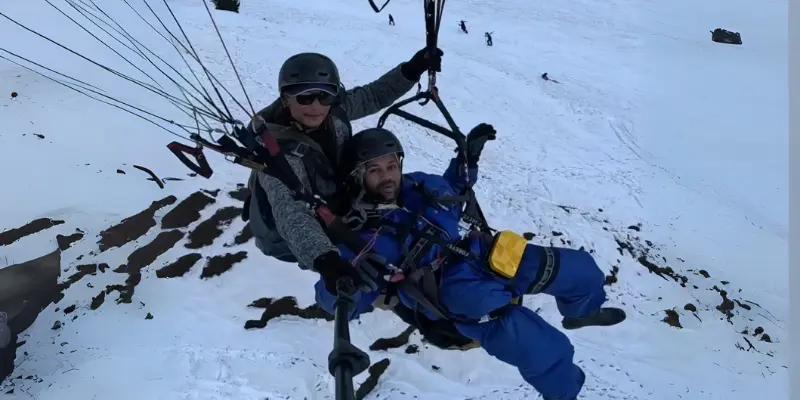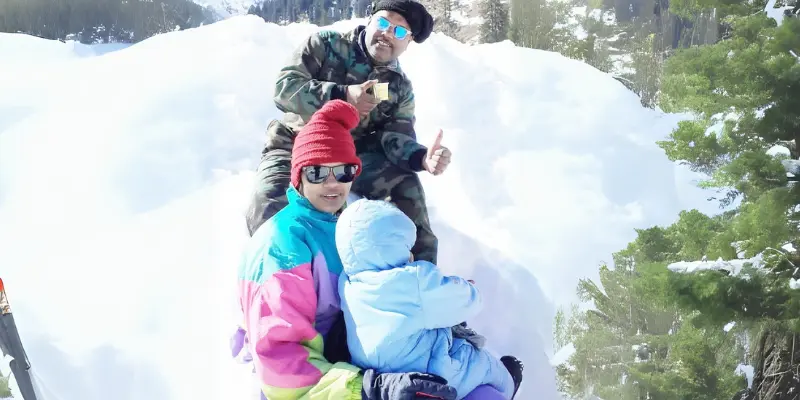Can You Paraglide in Solang Valley During Winter?
Published: 26 Jul 2025
Solang Valley in Himachal Pradesh is a dream destination for adventure lovers. It’s famous for its snow-covered mountains, clear blue skies and yes, paragliding! But many people wonder, “Can you actually paraglide in Solang during winter?” With snow all around and freezing temperatures, it seems unlikely, right?
Well, here’s the good news: Yes, you can!
Paragliding in winter is not only possible but it’s also one of the most breathtaking experiences you’ll ever have. Imagine flying over snow-covered peaks with the winter sun shining down. It’s cold, sure, but if you dress right and follow safety rules, it’s 100% worth it.

In this post, we are going to cover everything you need to know. Let’s help you get ready for a safe and thrilling winter flight in Solang Valley.
Is Paragliding Even Possible in Solang Valley During Winter?
Paragliding in Solang Valley doesn’t stop when winter arrives, it just changes a bit. While summer flights are more frequent, winter paragliding is possible when the weather plays nice. Think clear skies, calm winds, and just the right amount of sunshine on a snowy day.
Local operators keep a close eye on weather reports and only allow flights when it’s 100% safe. So, while you might not get to fly every day during peak winter, you still stand a good chance, especially in the late mornings and early afternoons.
How Cold Is It Up There?
It’s colder in the air than on the ground and no surprise there. As you rise higher, the temperature drops by around 6–10°C. Add in the wind chill and it can feel much colder while flying.
Example:
If the ground temperature is 7°C, it could feel close to 0°C in the air. So layering up is not just smart but it’s essential.
When Is It Too Cold to Fly?
Flights are usually paused if:
- Winds are too strong or gusty
- There’s heavy fog or snowfall
- Visibility is poor
- Temperatures are extremely low (close to freezing all day)
So, it’s best to keep your travel plan flexible and allow 1–2 buffer days, just in case the weather doesn’t cooperate.
What to Wear for Winter Paragliding in Solang Valley
Winter in Solang Valley is beautiful but biting cold. And when you’re flying hundreds of feet above ground, the wind makes it feel even colder. Dressing right is the secret to staying warm and enjoying every second in the sky.
Dress in Warm, Windproof Layers
You don’t need bulky clothes, just smart layering:
- Start with thermal inners (top + bottom)
- Add a fleece or wool sweater for insulation
- Top it with a windproof and waterproof jacket (essential for snow and air chill)
This combo keeps your body heat in and blocks the cold out.
Cover Your Hands, Ears & Eyes
Cold wind hurts more at high altitude, especially on bare skin:
- Wear gloves (preferably touchscreen-friendly)
- Use a balaclava or wool cap to cover your head and ears
- Don’t forget sunglasses or snow goggles, they protect your eyes from the glare off snow
Footwear Matters More Than You Think
Your feet need to stay warm and firm on snowy slopes:
- Wear thick socks (wool or thermal)
- Choose non-slip, high-ankle shoes like hiking boots
- Avoid sneakers with flat soles as they can slide on icy ground
Real-life tip: Many first-timers who wore running shoes had cold feet and poor grip. Hiking boots made all the difference!
Essential Winter Gear Checklist

Solang Valley winters are no joke, temperatures drop below zero and wind chill hits hard when you are flying. Here’s a simple gear checklist to make sure you’re warm, protected and ready to fly safely.
✅ Thermal Inners (Top + Bottom)
They trap your body heat and form the warmest base layer. Without thermals, you will feel the chill almost instantly in the air.
✅ Windproof Outerwear
Your jacket and pants should block wind and snow. Choose ones with adjustable cuffs and hoods for better insulation.
✅ Gloves + Warm Cap
Gloves protect your hands from freezing wind. A wool cap or balaclava keeps your head and ears covered, heat escapes fastest from your head!
✅ Sunglasses or Snow Goggles
Snow glare can be harsh and blinding. Good UV-protected eyewear helps you see clearly while flying and protects your eyes from dryness.
✅ Sunscreen & Lip Balm
Even in winter, UV rays reflect off snow and can cause sunburn. Apply SPF 30+ sunscreen and keep lip balm handy due to which cold air dries skin quickly.
Bonus Tip: Carry a small backpack to hold your gear, snacks and a water bottle. Travel light but smart.
Tips to Stay Warm Before and After Flight
Winter in Solang Valley can feel like a freezer, especially if you are waiting around before takeoff. But staying warm isn’t hard, just follow these practical tips to keep your body cozy and ready for the adventure.
Drink Warm Water or Herbal Tea
Warm fluids help maintain your core temperature. Sip slowly and avoid chilled drinks, they can lower your body temp fast.
Avoid Heavy Meals Before Flying
Eating too much before a flight can cause nausea while flying. Stick to something light like fruit, toast or soup.
Do Light Stretching
Before suiting up, stretch your legs, arms and back. It improves blood flow and keeps your body warm and flexible.
Keep Moving While You Wait
Don’t just sit around! Walk, swing your arms or do slow jumping jacks. This helps beat the cold and keeps your energy up.
Carry a Small Heat Pack
Pop one in your jacket pocket. It will keep your hands toasty while you wait and give instant comfort if it gets too cold.
Best Time in Winter to Paraglide in Solang
Wondering when to fly during the frosty months? While Solang Valley transforms into a snowy dream in winter, not every day is flyable. But don’t worry, there are golden windows when the skies open just for you.
December to February Overview
December
Early winter snow begins to settle in during December but skies often stay clear. Flights are more frequent during the first half of the month. It’s chilly but manageable with proper gear to paraglide in December.
January:
This is the toughest month for paragliding. Heavy snowfall and foggy mornings often lead to delays or cancellations. Operators stay on standby, waiting for safe wind conditions.
February:
As days start to get longer, short sunny spells return. These windows offer short but scenic winter flights. It’s a great month to try flying, especially after mid-February.
Example: In late February, pilots often complete 10–15 minute joyrides when the weather clears up after a snowstorm.
Best Time of Day
Late morning to early afternoon is your best shot. Why? Because by this time:
- The sun has melted any thin layer of morning frost.
- Winds are calmer and more predictable.
- Visibility is clearer, so you get better views and safer conditions.
Avoid early morning (too cold and foggy) and late afternoon (winds can turn gusty or unpredictable).
Safety and Winter-Specific Concerns
Paragliding in winter feels magical but it’s natural to wonder, is it really safe? Let’s clear up the common winter worries, especially for beginners, kids and older adults.
Is Breathing Cold Air Safe?
Yes, it’s completely safe for most people. Winter air might feel sharp at first, but since flights are short (5–15 minutes), your lungs handle it just fine.
Pro Tip: Wear a light neck gaiter or scarf. It warms the air slightly before it enters your lungs and adds comfort.
Example: Many flyers say the cold air feels fresh and energizing once you’re airborne.
Will Snow Affect Landing?
Yes but not in a bad way. Operators are very careful. They always choose clear, soft landing zones, even in snow. Dry patches, gently packed snow or slightly sloped hills are preferred. You will also get guidance during landing, so you don’t need to worry about slipping.
Tip: Wear proper shoes with grip (like hiking boots or snow sneakers).
Can Beginners Try in Winter?
Yes, beginners can fly in winter but only with trained operators and clear skies. If you are healthy and dressed warmly, winter flying is perfectly fine.
For kids and seniors:
- Children under 12 may not be allowed.
- Seniors with heart or breathing issues should consult a doctor.
- Operators often ask for verbal or written approval.
Example: A 62-year-old tourist flew in February with his grandson and loved the snowy views. It’s all about timing and preparation.
Final Thoughts
Yes, you can paraglide in Solang Valley during winter and it’s a breathtaking experience like no other. Flying over snow-covered peaks with crisp mountain air and sunny skies is something you will never forget.
Just remember the basics:
- Choose the right time (December to February when weather allows)
- Dress warmly in layers and windproof gear
- Follow your guide’s instructions
- Stay flexible in case weather changes suddenly
Whether you are a thrill-seeker or a first-timer, winter paragliding in Solang gives you a fresh way to see the Himalayas. So, pack your thermals, book with a trusted operator and let your winter adventure take flight!
Ready to soar? The snowy sky is calling.
Related Queries
Here is a list of related queries about winter paragliding in Solang Valley:
Yes, you can paraglide in Solang Valley during winter, especially from December to February. Operators fly on clear days when the skies are open and winds are stable. It’s a popular snow-season adventure.
Winter paragliding in Solang is safe if done with certified guides. Flights only happen in stable weather. You will get proper gear and safety checks before takeoff.
Wear thermal inners, a fleece or sweater and a windproof jacket. Add gloves, a warm cap, sunglasses and sturdy shoes. Dress in layers to stay warm.
Late morning to early afternoon is the best time to fly in winter. The sun is out, the winds are steady and visibility is good for scenic views and safe landings.
Yes, breathing cold air during short flights is safe. Use a neck gaiter or scarf to make it more comfortable and reduce dryness or chill on your throat.
Yes, beginners can fly in winter with trained instructors. It’s important to follow all safety instructions and fly only in good weather conditions.
Snow can affect landings, but guides choose dry or soft snowy zones for safe touchdown. They avoid icy or rough patches to keep it smooth.
Most operators either reschedule your flight or offer a refund. You can use the time to enjoy other winter activities like skiing, snow tubing or ropeways.
Yes, children below 5 and seniors above 65 may need approval. People with heart or breathing issues should consult a doctor before flying.
It’s best to book in advance during peak snow season. Weather changes fast, so early booking helps you get a confirmed slot on clear flying days.

- Be Respectful
- Stay Relevant
- Stay Positive
- True Feedback
- Encourage Discussion
- Avoid Spamming
- No Fake News
- Don't Copy-Paste
- No Personal Attacks



- Be Respectful
- Stay Relevant
- Stay Positive
- True Feedback
- Encourage Discussion
- Avoid Spamming
- No Fake News
- Don't Copy-Paste
- No Personal Attacks





